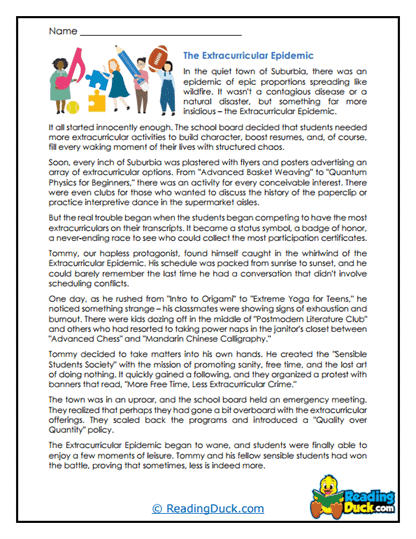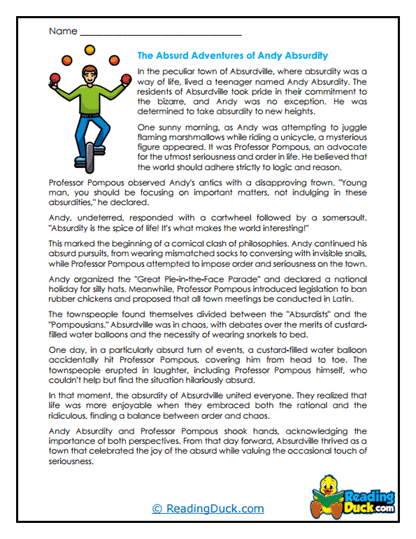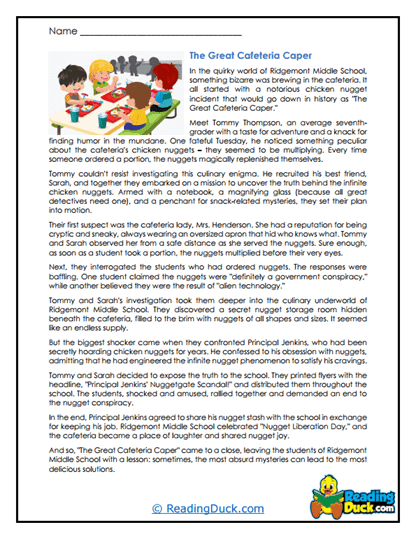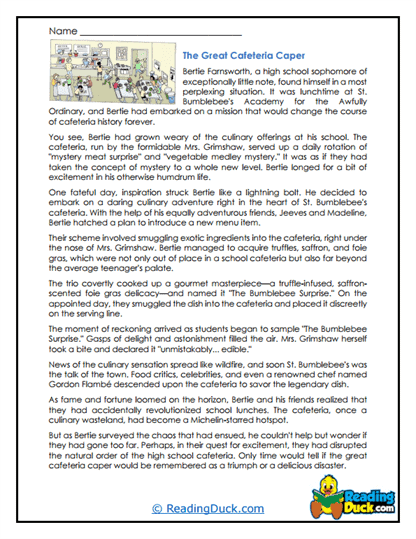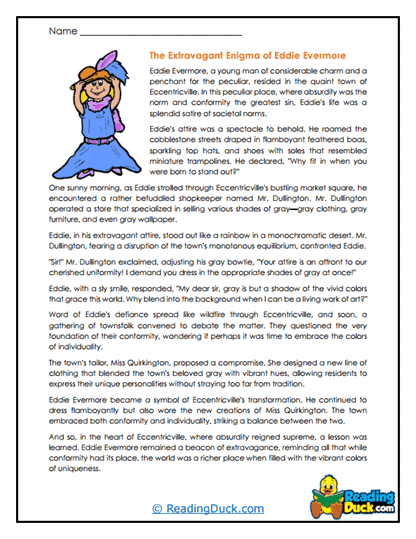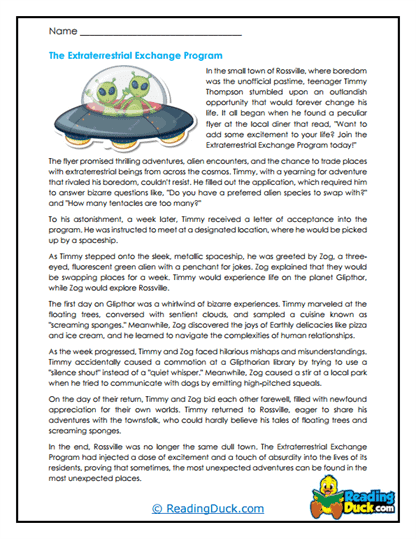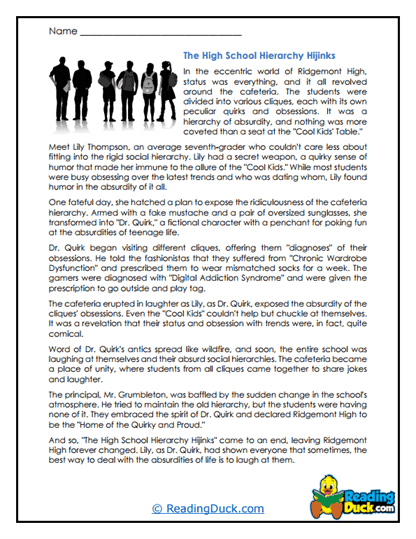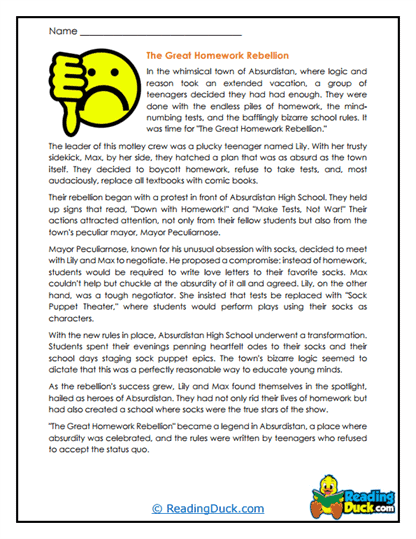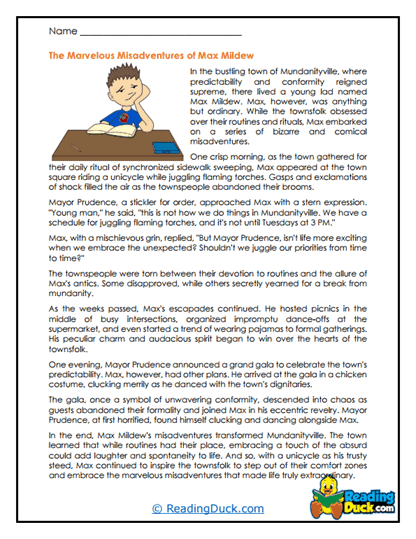Satire Passages Worksheets
About Our Satire Passages Worksheets
Our Satire Passages Worksheets offer an engaging and intellectually stimulating exploration of one of literature’s most powerful tools—satire. Designed to help students navigate the complexities of this genre, each worksheet set includes a carefully selected reading passage that exemplifies key elements of satire. The worksheets come with a variety of question formats, including multiple-choice questions to check comprehension, short-answer prompts for deeper analysis, and open-ended questions to encourage creative interpretation and expression.
The worksheets are provided in a PDF format, making them easily accessible for download, printing, and use across devices. Each set also includes a downloadable answer key, allowing for quick grading and providing educators with valuable time-saving solutions. These worksheets are best suited for middle school and high school students, though they can be adapted for upper elementary learners. Whether you’re teaching in a traditional classroom, managing a homeschool curriculum, or supporting independent study, our Satire Passages Worksheets will help students develop key skills in critical thinking, reading comprehension, and creative writing.
Understanding the Satire Genre
Satire is a genre that uses humor, irony, exaggeration, or ridicule to expose and criticize the flaws of individuals, institutions, or societies. Satire has been used for centuries as a way to address political, social, and cultural issues, often challenging the status quo and encouraging readers to reflect on the underlying problems in the world around them. Whether it’s Jonathan Swift’s biting critique of British colonialism in A Modest Proposal or George Orwell’s satirical examination of totalitarian regimes in Animal Farm, satire plays an essential role in both literature and social commentary.
Key themes and characteristics of satire include:
- Critique of society: Satire often targets societal flaws such as corruption, hypocrisy, or injustice, using humor to expose uncomfortable truths.
- Irony and sarcasm: Satirical works frequently employ irony, sarcasm, and exaggeration to make their points, highlighting the absurdity or contradictions within social norms or political systems.
- Exaggeration and parody: Satire amplifies certain aspects of its subjects to make them seem more ridiculous or to emphasize the need for change.
- Moral or ethical lessons: Despite its often humorous or exaggerated tone, satire frequently conveys deeper moral or ethical messages, prompting readers to reflect on serious issues beneath the surface.
Satire is essential to fiction because it offers a way to challenge authority, question societal norms, and provoke thought. It forces readers to confront uncomfortable truths in a way that is both entertaining and intellectually stimulating. Our Satire Passages Worksheets encourage students to explore this dynamic genre, enabling them to recognize the techniques used by satirists and engage critically with the underlying messages in these texts.
Enhancing Reading Comprehension and Critical Thinking
Our Satire Passages Worksheets are designed to help students enhance both their reading comprehension and critical thinking skills by encouraging them to engage deeply with the text. Satire, with its layers of meaning, requires careful analysis and interpretation to fully understand the author’s intent, making it a perfect genre for developing these skills.
The worksheets focus on:
- Reading Comprehension: Multiple-choice questions assess students' understanding of the basic plot, characters, and setting. They encourage students to identify key elements, such as the target of the satire and the tools (irony, exaggeration) used by the author.
- Critical Analysis: Short-answer questions prompt students to reflect on the deeper meaning behind the text. These questions might ask students to explain the satirist’s message or analyze how the use of humor enhances the critique of a particular societal issue.
- Creative Interpretation: Open-ended questions invite students to engage creatively with the satire, asking them to imagine alternative scenarios, rewrite sections with a different tone, or create their own satirical passages inspired by the themes in the reading.
For example, a worksheet on a passage from Animal Farm might include multiple-choice questions that ensure students understand the allegorical elements, such as which animals represent historical figures or political ideologies. Short-answer questions might ask students to explore how Orwell uses irony to critique propaganda. An open-ended question could encourage students to rewrite a scene in modern times, exploring how the same satirical techniques could apply to contemporary issues. This combination of factual, analytical, and creative tasks helps students build a comprehensive understanding of satire.
Examining the Techniques of Satire
Satire relies on a range of unique storytelling techniques to deliver its message in a humorous or exaggerated manner. Our Satire Passages Worksheets guide students through these techniques, helping them understand how satire uses humor, irony, and exaggeration to critique its subjects while still conveying serious themes.
Key storytelling techniques explored in the worksheets include:
- Irony and Sarcasm: These devices are central to satire, where the surface meaning of a statement is often the opposite of its true meaning. Students will analyze how authors use irony to expose hypocrisy or absurdity in the text.
- Hyperbole: Exaggeration is a common tool in satire, used to magnify the flaws or issues being criticized. Students will examine how authors amplify certain elements to make their critiques more pointed and impactful.
- Parody and Mimicry: Many satirical works parody well-known figures, institutions, or literary styles. Students will explore how parody functions within the text and what it reveals about the author’s attitude toward the subject.
- Humor with a Purpose: Though satire often entertains, it is ultimately designed to provoke thought. Students will explore how the humor serves a larger purpose, often revealing uncomfortable truths about society, politics, or human nature.
For example, in a worksheet featuring an excerpt from Mark Twain’s The Adventures of Huckleberry Finn, students might explore how Twain uses irony and exaggeration to critique issues of racism and social inequality. Short-answer questions could ask them to analyze how Twain uses specific dialogue to highlight the absurdity of certain social norms. Open-ended questions might encourage students to create their own satirical dialogue that reflects a modern-day societal issue, challenging them to apply the techniques of satire to their own writing.
Encouraging Analytical Thinking and Creative Expression
Our Satire Passages Worksheets offer an excellent opportunity for students to develop both their analytical thinking and creative writing skills. Satire’s layered and often ambiguous meaning makes it a perfect genre for students to analyze character motivations, plot development, and thematic elements while encouraging them to think critically about the real-world issues behind the humor.
Through these worksheets, students will:
- Analyze thematic elements: Students are encouraged to identify the key themes of the satire, such as social injustice, political corruption, or cultural absurdities. They will examine how the author’s use of humor and irony enhances these themes and drives the narrative forward.
- Interpret plot developments: Satire often takes unexpected turns, and students will be asked to interpret how these plot developments support the satirical message. They will also explore how conflicts between characters symbolize broader societal issues.
- Create alternative endings or scenarios: Open-ended questions often ask students to imagine how the satire might play out differently, encouraging them to rewrite sections of the passage with different outcomes or modern-day contexts. These creative exercises foster imaginative thinking while reinforcing their understanding of satirical techniques.
For example, a worksheet based on Jonathan Swift’s A Modest Proposal might ask students to analyze Swift’s use of hyperbole in proposing an outrageous solution to poverty. Open-ended prompts could invite students to craft their own satirical proposal for addressing a contemporary issue, challenging them to apply Swift’s method of exaggeration and irony to new contexts. These tasks promote active learning and help students develop a deeper appreciation for satire’s role in fiction and society.
Versatile Use in Various Educational Settings
The Satire Passages Worksheets are designed to be adaptable across different educational environments, making them an ideal resource for both group and individual learning. Whether used in a traditional classroom, as part of a homeschooling curriculum, or in independent study, these worksheets offer a flexible approach to teaching satire and fostering critical thinking skills.
- In the classroom, teachers can use these worksheets as part of a larger unit on literary genres, humor, or social commentary. They work well for group discussions, allowing students to debate the meaning behind the satire and share their interpretations.
- For homeschooling, the PDF format makes these worksheets easy to print and use as a supplement to literature lessons, encouraging independent exploration of complex ideas.
- In independent study, students can work through the materials at their own pace, developing a deeper understanding of satire’s unique narrative techniques and honing their analytical skills.
Supporting Individual and Collaborative Learning
Our Satire Passages Worksheets are designed to support both individual exploration and collaborative group work. Students working independently can use the worksheets to engage deeply with satirical texts, while group activities foster collaborative analysis and creative discussions about the satire’s meaning and relevance.
Overall, the Satire Passages Worksheets provide a comprehensive tool for developing reading comprehension, critical analysis, and creative expression. By guiding students through the nuances of satire, these worksheets help them engage more fully with one of literature’s most powerful forms of social critique, fostering both intellectual growth and imaginative thinking.
